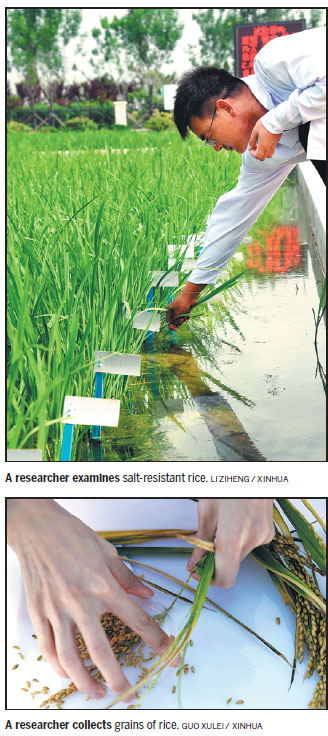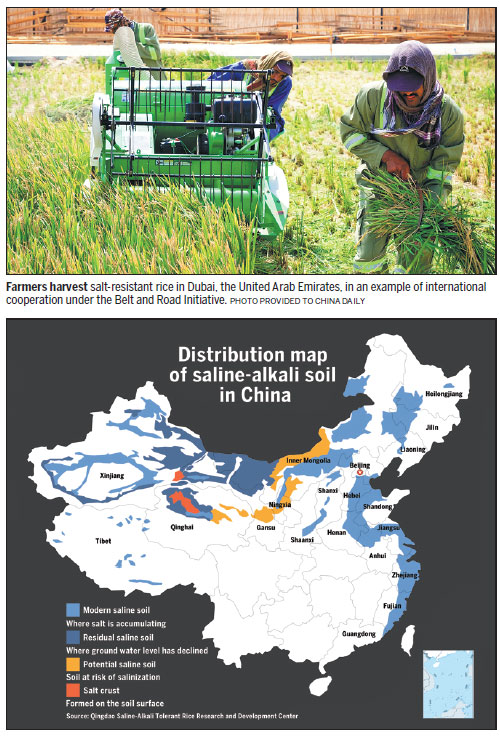'Seawater rice' rides tide of hope and hype

A test next year will determine whether new strain can be grown commercially, Xie Chuanjiao reports from Qingdao, Shandong.
Research and experimental plantings of a crop hyped by Chinese media as "seawater rice" hold out the promise of turning vast areas of wasteland green and boosting food security.
However, experts caution there is a long way to go to prove the commercial viability of what is more properly called salt-resistant rice.
Also known as saline-alkali tolerant rice, it is designed to grow in tidal flats or other areas with heavy salt content and has been developed by plant-breeding experts through crossbreeding and other technologies.
The world has 950 million hectares of land that is saline and alkaline, with Asia accounting for about a third of the total.
China has 100 million hectares of saline-alkaline soil, and growing rice in such swamps, bogs, clayish land and brackish coastal areas has typically been impossible because salt stresses the plants.
Renowned Chinese agricultural scientist Yuan Longping said this year that based on a yield of 4.5 metric tons a hectare, his program's target, planting salt-resistant rice on 6.67 million hectares of land, would increase rice production by 30 million tons a year - enough to feed 80 million people.
Yuan, who has been dubbed China's "father of hybrid rice", is known for developing the first hybrid rice varieties in the 1970s. His hybrid rice development has greatly enhanced China's rice yields and contributed to ensuring the country's food security, as about 65 percent of the population depends on rice as a staple food.
The octogenarian has focused on salt-resistant rice for the past three years and led a team that established a research and development center for it in Qingdao, in eastern China's Shandong province, in September 2016.
The Qingdao Saline-Alkali Tolerant Rice Research and Development Center, where Yuan is chief scientist, aims to use molecular breeding technologies to develop salt-resistant rice strains that can be widely planted on saline-alkaline land in places with different climates.
When it was established, the center set itself a three-year target of developing a salt-resistant rice strain capable of yielding 4.5 tons a hectare. The average rice yield in China is 6.75 tons a hectare.
It planted the first batch of salt-resistant rice in two experimental paddies just north of Jiaozhou Bay in April last year and reaped the harvest five months later.
Agricultural experts who monitored the harvest said the highest-yielding of the four varieties planted produced 9.3 tons a hectare, while the other three returned 8.2 tons, 7.4 tons and 6.6 tons - all above the center's three-year target.
The experts said yields from regular cultivation might reach 70 to 80 percent of those achieved in small, experimental plantings.
Zhang Guodong, deputy director of the Qingdao center, said the results showed the salt-resistant rice strain they developed could survive and return high yields in water with 0.6 percent salt content. Seawater is 3.5 percent salt.
The research team extended trial planting of salt-resistant rice to six plots of saline-alkali land across China in late May. It was the first simultaneous planting of such rice on different types of saline-alkali land and a major step in exploring its commercial viability.
The sites - in Kashgar, in the Xinjiang Uygur autonomous region; Daqing, Heilongjiang province; Dongying and Qingdao in Shandong; Wenzhou, Zhejiang province; and Yan'an, Shaanxi province - represent virtually every type of saline-alkali land in China.
Yuan's team is not the only one in China focusing on salt-resistant rice.
Working separately, Chen Risheng, an agriculturist based in Zhanjiang, Guangdong province, started to study salt-resistant rice in 1986. However, his story has attracted less media attention.
Guangming Daily reported in October 2016 that Chen's research began when he came across a species of red wild rice near a mangrove forest in Zhanjiang with his teacher Luo Wen. Inspired by Luo, Chen selected 522 seeds and embarked on breeding work.
In the following three decades, Chen selected promising strains and worked on seed purification and reproduction.
He started trial planting in several places in China in 2012, the year his "Seawater 86" was given intellectual property rights recognition by national agricultural authorities.
A report by China Youth Daily in early January recounted Chen's hard work and unremitting efforts in 30 years of research, but also mentioned that he had faced many difficulties, including a lack of funds and professional knowledge.
The efforts of Yuan and Chen to develop salt-resistant rice have attracted a lot of praise on social media, but many Chinese experts have cautioned that their work is still in its infancy.
In mid-July, Science and Technology Daily cited rice expert Ling Qihong as saying in an academic article in the periodical China Rice, which is sponsored by the China National Rice Research Institute, that it is difficult to plant rice on a wide range of wasteland and there is still a long way to go.
Media attention
Ling said China had accumulated rich experience in cultivating rice on saline and alkaline land, but the breakthroughs in salt-resistant rice strains could not deny the role fresh water from irrigation played in leaching out salt.
"It also depends on long-distance transportation of huge amounts of fresh water, which is time-consuming and a big project," Ling wrote, adding that the name "seawater rice" could cause misunderstandings. After learning that salt-resistant rice was irrigated by diluted seawater on the Qingdao experimental paddies, Ling said it was not right to call it "seawater rice".
In a more recent report in Science and Technology Daily, another plant breeding expert, Li Liqiu, echoed Ling, describing the name "seawater rice" as a stunt designed to maximize media attention.
Researchers from the Qingdao center said Ling's opinion was based on the early stage of salt-resistant rice research.
Zhang said the research team has developed a core technology called the "four-dimensional optimizing method" which tailors solutions for different soil types by taking advantage of the internet of things, soil conditioner, plant growth regulator and the rice's resistant capabilities.
Ling also cited Dai Qigen, a professor from the College of Agriculture at Yangzhou University, as saying that rice only survives in water with a salt content no higher than 0.3 percent.
Zhang said Dai's conclusion was out of date, and the Qingdao center's new salt-resistant species had lifted the tolerable salt content to 0.6 percent.
"Water with a salt content higher than 0.1 percent cannot be used in traditional agricultural production for irrigation," Zhang said. "That means we have more choice of water resources if planting salt-resistant species. Besides which, long-distance transportation of fresh water is not necessary and water can be acquired nearby."
Experts say salt-resistant rice has unique nutritional advantages that may bring potential health benefits.
"Salt-resistant rice grown on saline-alkaline land has more mineral content than ordinary rice because salt water contains high levels of microelements," Yang Hongyan, who worked at the Qingdao center, said in a previous interview with China Daily.
"In addition, salt-resistant rice growing in a natural environment is not contaminated by heavy metals and isn't subject to plant diseases or insect pests."
Mi Tiezhu, deputy director of the Qingdao center's technical department, said "seawater rice" could be considered a catchy folk name rather than an academic term, and confirmed that researchers working on Qingdao's experimental paddies had mixed fresh water and seawater in one field.
He said government officials and agricultural experts will test its salt-resistant rice next year to decide whether it can be grown commercially.
Mi said he was confident of the rice's commercial prospects. "Our investigations suggest that salt-resistant rice has a wide potential market," he said.
Rural Taobao, a branch of Chinese e-commerce giant Alibaba, announced in June that it would cooperate with Yuan's team to help promote salt-resistant rice in the market.
Overseas cooperation
The Qingdao team's salt-resistant rice has also spread to desert areas of Dubai in the United Arab Emirates, becoming an example of international cooperation under the China-led Belt and Road Initiative.
An international expert group tested five types of harvested salt-resistant rice in Dubai in late May, with yields ranging from 4.8 to 7.8 tons a hectare. It marked the first successful experimental planting of rice in a tropical desert.
Sheikh Mohammed Bin Rashid Al Maktoum, vice-president and prime minister of the UAE, attached great importance to the successful trial planting. To commemorate the historic breakthrough, the harvested salt-resistant rice was named "Al Marmoom", after an area in Dubai, and will be presented to distinguished guests as a "national gift", further promoting cooperation with the Qingdao team.
The Qingdao team launched the project in Dubai in early January, and from May to July more than 80 varieties of experimental rice, including salt-resistant rice, matured in batches.
Growing rice in desert areas faces many challenges and difficulties, including extreme temperatures, highly saline water, low humidity, lack of fresh water, sandstorms, lack of proper soil and a lack of agricultural resources.
The research team introduced the "four-dimensional optimizing method" applied in planting salt-resistant rice in China to Dubai, with sensors that tell farmers when to adjust water and nutrient levels.
The two sides are taking a multistep approach to developing salt-resistant rice planting, with the goal of turning at least 10 percent of the UAE's territory into green land.
They will also build a salt-resistant rice research center for the Middle East and North Africa, with the aim of creating "artificial oases" to benefit all Arab countries by helping them eradicate poverty and hunger and make the environment more livable.
Contact the writer at xiechuanjiao@chinadaily.com.cn

A technician collects rice seedlings for transfer to a salinity test field at the Qingdao Saline-Alkali Tolerant Rice Research and Development Center.Li Ziheng / Xinhua


MOST POPULAR
- 1 China to give visa-free treatment to another 9 countries
- 2 China fully opens manufacturing sector to foreign investors in landmark opening up move
- 3 China's import expo attracts record-breaking participating countries, exhibitors
- 4 China's door opening even wider to foreign visitors, businesses
- 5 China revises rules to ease foreign strategic investment in listed firms
Editors' Picks
 Video:
Peru sees new port open
Video:
Peru sees new port open
 Infographic:
China's public holidays for 2025
Infographic:
China's public holidays for 2025
 Infographic:
Basic facts of APEC
Infographic:
Basic facts of APEC
 Infographic:
Wrapping up the 7th CIIE: Data recap
Infographic:
Wrapping up the 7th CIIE: Data recap



